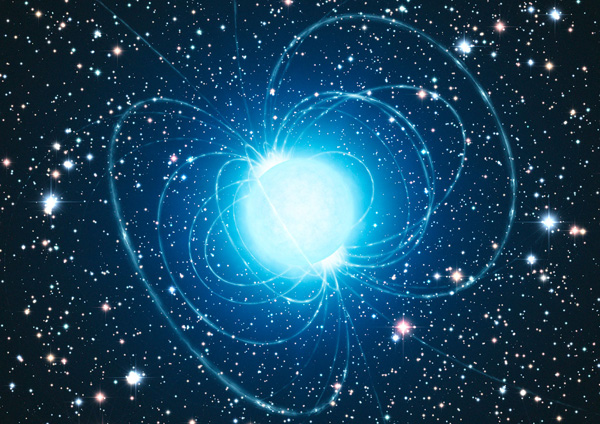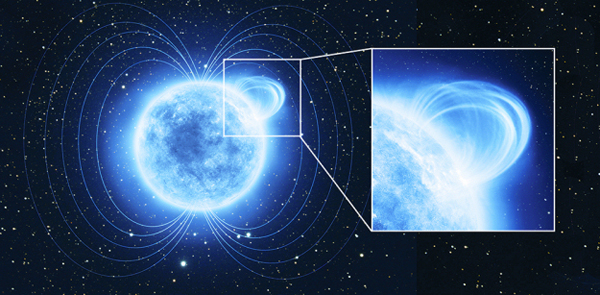Magnetar
 A magnetar (a contraction of the words magnetic star) is a neutron star that has a huge magnetic field, million billion times that of the Earth, whose decay generates intense and abundant electromagnetic radiation, particularly X-rays and rays range. The theory regarding these objects was formulated by Robert Duncan and Christopher Thompson in 1992. During the following decade, the magnetar hypothesis has been widely accepted as a possible explanation for certain physical objects known as soft gamma repeaters (recurring sources of soft gamma rays) and anomalous X-ray pulsars
A magnetar (a contraction of the words magnetic star) is a neutron star that has a huge magnetic field, million billion times that of the Earth, whose decay generates intense and abundant electromagnetic radiation, particularly X-rays and rays range. The theory regarding these objects was formulated by Robert Duncan and Christopher Thompson in 1992. During the following decade, the magnetar hypothesis has been widely accepted as a possible explanation for certain physical objects known as soft gamma repeaters (recurring sources of soft gamma rays) and anomalous X-ray pulsars
Formation.
When during a supernova explosion a star collapses into a neutron star, its magnetic field is growing dramatically in power (while the size is halved, the power quadruples). Duncan and Thompson calculated that the magnetic field of a neutron star, normally about 108 tesla, may, by an effect similar to the dynamo, become even larger, higher tesla to 1011 (or 1015 gauss), such a neutron star that is precisely the magnetar.
A supernova explosion, during the explosion, comes to losing 10 % of its mass. In the case of very massive stars (10-30 solar masses) that, as a result of the explosion, do not turn into holes blacks, they lose much of their mass, about 80%.
It is estimated that about 1 in 10 supernova degenerate into a.jpg) magnetar rather than a more common neutron star or a pulsar. This happens when the star has already been before the supernova a fast rotation and strong magnetism. It is believed that the magnetic field of a magnetar is origins as the result of a
magnetar rather than a more common neutron star or a pulsar. This happens when the star has already been before the supernova a fast rotation and strong magnetism. It is believed that the magnetic field of a magnetar is origins as the result of a
convective motion to the dynamo effect of hot material in the core of the neutron star that elapses in the first 10 seconds of life of the star; if the star wheel itself initially to the same speed of the period of convection, about 10 milliseconds, convection currents are able to operate globally on star and to transfer a significant amount of their kinetic energy in the strength of their magnetic field. In neutron stars that rotate less rapidly, the convective cells are formed only in certain regions of the star.
A short life.
In the outer layers of the magnetar, which is composed of plasma of heavy elements (mainly iron), the tensions that arise from the twisting of the lines of force of the stellar magnetic field can cause a "starquake", or the crust of the neutron star is split by the intense magnetism and sinks in the inner layer in a way very similar to what happens to the earth's crust during an earthquake. These seismic waves are highly energetic and lead to a strong emission of X-rays and gamma; astronomers call this object soft gamma repeaters.
The active life of a magnetar is short enough: the strong magnetic fields decay after about 10,000 years, after which they cease to be the activity that the X-ray emission most likely the Milky Way is full of magnetar off.
Effects of the strong magnetic field.
A magnetic field of about 10 gigatesla is able to demagnetize a credit card by half the distance between the Earth and the Moon. A small neodymium magnet consisting of the lanthanide has a field of about 1 tesla, the Earth has a geomagnetic field of 30-60 microtesla, and most of the systems storing the data can be severely damaged by a field of a mT from a short distance.
The magnetic field of a magnetar can be deadly from a distance of 1000 km, as it can tear the organic tissues due to the diamagnetism of water, as well as the iron in hemoglobin. The tidal forces of a magnetar of 1.4 solar masses are just as deadly at the same distance, able to tear a man of medium build with a force of more than 20 kilonewton (over 2040 pounds - force.
In 2003, in the journal Scientific American described what was happening in the magnetic field of a magnetar: the X-ray photons are split into two parts or blend together, while the photons polarized light, when they enter the magnetic field, change speed and (sometimes wavelength). As long as the field is able to prevent the electrons to vibrate, as they normally would in response to the stress of the light, the light waves "glide" over the electrons without losing energy. This occurs more easily in a vacuum, where you can split the light into different polarizations (as in a crystal of immaterial calcite).

Such a magnetic field "stretches" the atoms into long cylinders. In a field of about 105 tesla, atomic orbitals deform until the shape of a cigar. A 1010 tesla, a hydrogen atom stretches to become 200-fold tighter than its normal diameter.
Magnetar known.
- SGR 1806-20, located 50,000 light-years from Earth, on the opposite side of the Milky Way in the constellation of Sagittarius.
- 1E 1048.1-5937, located 9,000 light-years away in the constellation Carina. The star from which originated the magnetar had a 30-40 times the solar mass.
In late June 2012, the number rose to 20 recognized and other 3 candidates.


 A
A .jpg) magnetar rather than a more common neutron star or a pulsar. This happens when the star
magnetar rather than a more common neutron star or a pulsar. This happens when the star 

